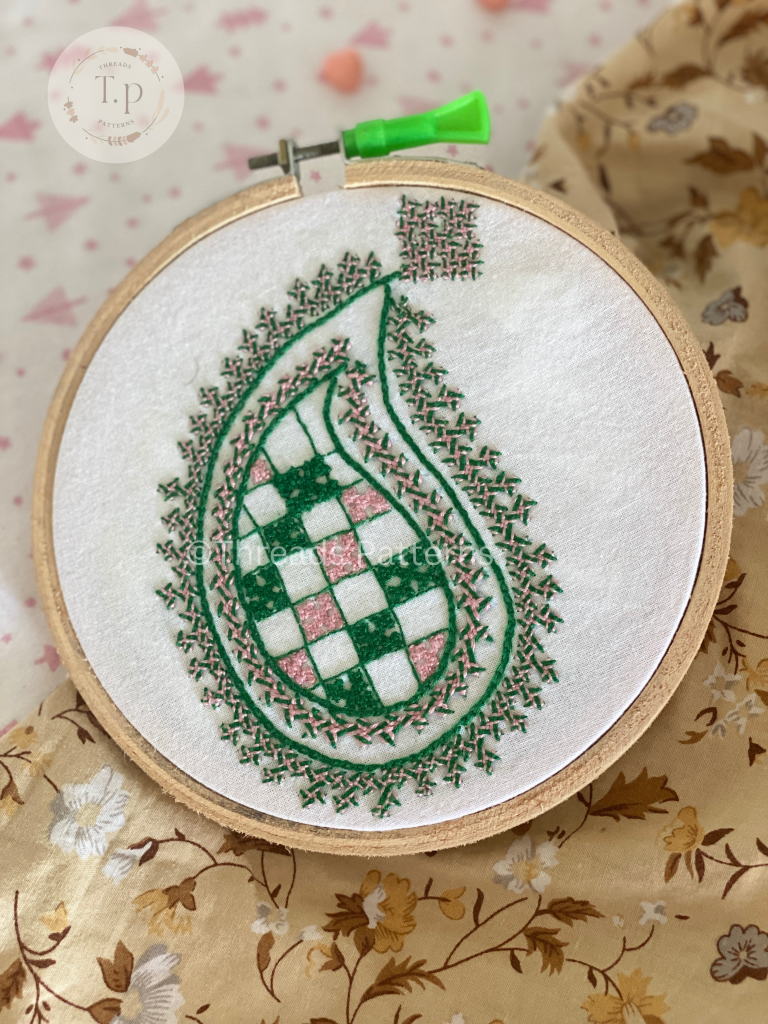The mango stitch in Kutch work is a variation of traditional Kutch embroidery, often used to create designs resembling the shape of a mango, which is a popular motif in Indian embroidery. This stitch is made by using the basic interlacing technique that is common in Kutch work, where threads are woven in a structured grid pattern to form the outline of the mango shape. The mango stitch involves filling the shape with intricate patterns, often using chain stitches, herringbone stitches, or running stitches to add texture and detail.
This stitch is often used in borders or as a central motif in Kutch embroidery designs, making it a key element in many traditional patterns.

The interlacing stitch is the core of Kutch work, and it’s used to outline and structure the mango shape. Begin by working around the outline of the mango, using the interlacing stitch to create a continuous, interconnected pattern. The interlacing stitch involves weaving the thread over and under in a grid-like formation, giving the mango shape a slightly raised, textured appearance.
- Bring your needle up through the fabric at the starting point of the outline.
- Insert the needle back into the fabric a few millimeters away, leaving a loop of thread on the surface.
- Bring the needle up again inside the loop and pull the thread tight to form the first interlaced stitch.
- Continue this process along the entire outline of the mango shape, maintaining an even tension to create a neat and uniform pattern.
This stitch not only outlines the mango shape but also forms the foundation for adding other decorative stitches.
Once you’ve created the outline, you can add the chain stitch inside the mango shape to create more intricate details. The chain stitch is perfect for creating curved lines and filling the mango with beautiful patterns.
- Starting from the base of the mango, bring your needle up through the fabric.
- Make a small loop with the thread and insert the needle back into the same spot, leaving the loop on the surface.
- Bring the needle up again inside the loop and pull it tight to create the first chain.
- Continue creating chain stitches, following the curve of the mango shape. You can create multiple rows of chain stitches to add depth and texture to the design.
The chain stitch can also be used to create smaller, decorative elements within the mango, such as tiny flowers, spirals, or vines, depending on your design.
Once you’ve outlined the mango, mark the location where you want to place the small square. The square can be centered or placed asymmetrically within the mango, depending on the design you are aiming for. Use a pencil or erasable fabric marker to lightly sketch a square in the desired location inside the mango.
To create the small square, use the interlacing stitch, a staple in Kutch work. This stitch creates a raised and interconnected appearance, which is perfect for geometric shapes like squares. Follow these steps:
- First Diagonal Line: Start by bringing the needle up at one corner of the square outline. Make a diagonal stitch across the square to the opposite corner.
- Second Diagonal Line: From the other corner, bring the needle back up and make a diagonal stitch to the remaining corner, crossing over the first stitch. Now, you should have an “X” shape inside the square.
- Horizontal and Vertical Lines: Next, stitch two lines—one horizontal and one vertical—through the center of the square, connecting the midpoints of the sides. This creates a grid-like pattern that forms the basic structure of the square.
Once you’ve created the basic square grid, it’s time to start interlacing the threads to give the design its characteristic Kutch embroidery texture.
- Bring the needle up through the fabric at the point where the horizontal and vertical lines intersect in the middle of the square.
- Weave the needle over and under the diagonal stitches you’ve created earlier, following the “X” shape.
- Continue weaving until the thread forms a raised, textured square. Keep the tension even to maintain a neat appearance.
This combination of structured and free-form patterns is what makes Kutch work so visually captivating.


